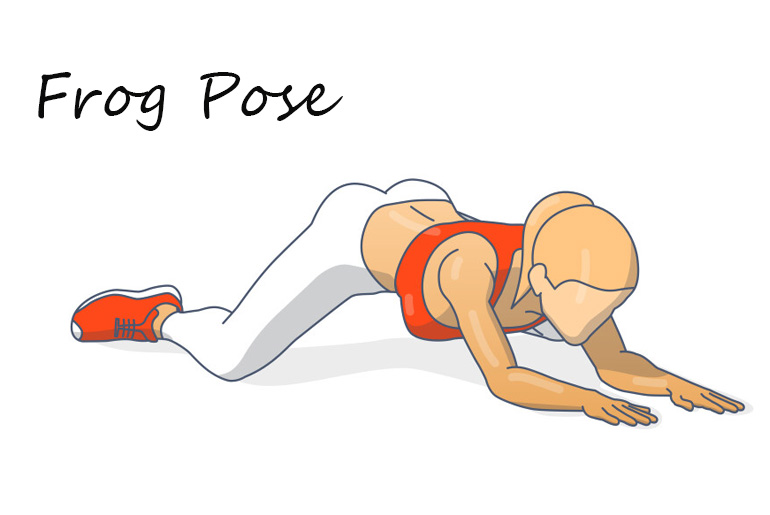If your job involves prolonged sitting, which often leads to bad posture and back pain, incorporating the Frog Pose, or Mandukasana, into your routine can be highly beneficial. This powerful yoga pose helps alleviate back pain and increase mobility. Despite its simple appearance, Mandukasana is an effective way to enhance overall mobility. Regular practice can also improve digestion, strengthen muscles, and provide several other health benefits. Additionally, the Frog Pose serves as a preparatory pose for more advanced hip-opening asanas.
Mandukasana or Frog Pose:
Mandukasana, or Frog Pose, is a yoga asana named after the Sanskrit words “manduka” (frog) and “asana” (pose), as the final position resembles a frog’s stance. This pose is a deep hip opener that significantly enhances flexibility and strength. According to yoga expert Dr. Hansaji Yogendra Vasudeva, it is a powerful addition to any yoga practice, especially after a warm-up, due to its benefits in improving posture and overall mobility. Regular practice of Mandukasana can also aid in digestion and muscle strength, making it a versatile and beneficial pose for overall well-being.
Benefits of Frog Pose (Mandukasana):
The Frog Pose, or Mandukasana, is a highly beneficial yoga posture that offers a range of physical and mental health advantages.
- Opens Up Hips and Improves Mobility: Regular practice of the Frog Pose significantly enhances hip mobility and flexibility. This pose is especially effective for individuals who spend extended periods sitting at a desk or in a vehicle, as it helps to relieve chronic muscle tension. Improved hip flexibility from practicing this pose can also make it easier to sit cross-legged on the floor, contributing to better overall body balance and mobility.
- Reduces Lower Back Pain: Studies, such as the one published in the Journal of Orthopaedic Rheumatology, have shown that daily yoga practice can alleviate back pain. The Frog Pose specifically targets the spine and hip areas, lengthening the spine and releasing tension in the hips. This makes it an excellent practice for reducing lower back pain and stiffness, providing relief to those who suffer from chronic back issues.
- Keeps Stress at Bay: Yoga is well-known for its stress-reducing properties, and the Frog Pose is no exception. According to research published in the International Journal of Yoga, regular yoga practice increases focus, reduces stress and anxiety, and boosts overall mental health. The Frog Pose has a soothing effect on the mind, helping to relieve tension and provide a sense of calm, making it an effective tool for stress management.
- Improves Digestion: The Frog Pose can enhance digestive health by applying gentle pressure to the abdomen, which stimulates digestive organs and encourages regular bowel movements. This can help alleviate constipation and improve overall digestion. As Dr. Hansaji points out, the pose’s benefits to the digestive system are significant and contribute to better gut health.
- Enhances Blood Circulation: Practicing the Frog Pose enhances blood flow to the pelvis, which improves general circulation and can alleviate menstruation discomfort. This is particularly beneficial for individuals who sit or stand for long periods, as it minimizes swelling and reduces the risk of developing blood clots. Improved circulation also supports overall cardiovascular health.
- Improves Sleep: The Frog Pose promotes relaxation and reduces stress, making it easier to fall asleep and enhancing overall sleep quality. Research published in the Brain, Behavior, and Immunity Integrative journal indicates that yoga can minimize sleep onset delay, extend the sleeping period, and improve sleep quality. Incorporating the Frog Pose into a bedtime routine can lead to better, more restful sleep.
The Frog Pose offers numerous benefits, including improved hip mobility, reduced lower back pain, stress relief, better digestion, enhanced blood circulation, and improved sleep quality. Regular practice of this pose can lead to significant improvements in both physical and mental well-being.
How to Do Frog Pose (Mandukasana)
Step 1: Start in a Tabletop Position
- Begin on your hands and knees, ensuring your wrists are directly under your shoulders and your knees are under your hips.
Step 2: Widen Your Knees
- Slowly move your knees apart, guiding them toward the edges of your mat. Find a position where you feel a gentle stretch without discomfort.
Step 3: Turn Your Toes Outward
- Rotate your toes outward and flex your feet so the inner edges of your feet rest on the floor.
Step 4: Lower Onto Your Forearms
- Gradually lower your upper body onto your forearms, keeping them parallel to each other and elbows under your shoulders.
Step 5: Slide Your Hips Back
- Slide your hips back slightly, ensuring that your ankles remain in line with your knees.
Step 6: Maintain a Neutral Spine
- Keep your spine neutral, avoiding arching or rounding your back.
Step 7: Hold the Pose
- Hold the pose for 30 seconds to 5 minutes, depending on your comfort level.
Breathing Pattern:
Inhale deeply through your nose, allowing your belly to expand.
Exhale gently through your nose, feeling your belly constrict.
Aim for a 1:2 inhale-to-exhale ratio (e.g., 4 counts in, 8 counts out).
Continue this breathing pattern throughout the pose, enhancing relaxation.
Side Effects of Frog Pose (Mandukasana)
Potential Issues and Contraindications:
- Digestive Problems: Avoid this pose if you have eaten recently, as it can cause discomfort.
- Headaches: Some people might experience increased head pressure.
- Back Pain: Those with back issues might find this pose exacerbates their pain.
- Knee and Hip Pain: Overdoing the pose can strain these joints.
- Not Suitable for Everyone: Pregnant women, people with high blood pressure, or those who have had recent abdominal surgery should avoid this pose.
Things to Keep in Mind
- Avoid Overexertion: Practice mindfully and avoid pushing your body too hard.
- Proper Alignment: Ensure correct alignment to prevent injury.
- Listen to Your Body: Pay attention to your body’s signals and adjust the pose as needed.
- Consult a Professional: If you have specific health concerns or conditions, consult a healthcare provider or a qualified yoga teacher before practicing.
By following these guidelines and being mindful of the potential side effects, you can safely practice Frog Pose and enjoy its numerous benefits.
Disclaimer:
The information contained in this article is for educational and informational purposes only and is not intended as a health advice. We would ask you to consult a qualified professional or medical expert to gain additional knowledge before you choose to consume any product or perform any exercise.








